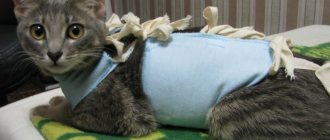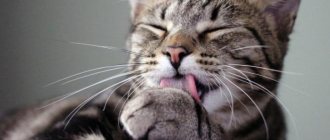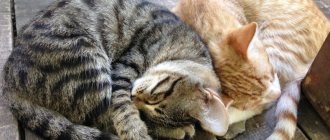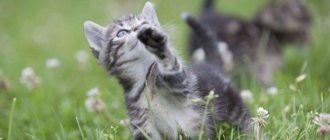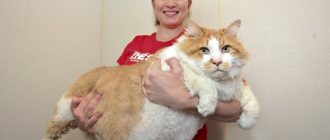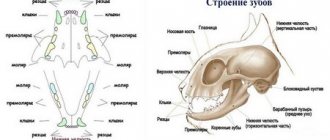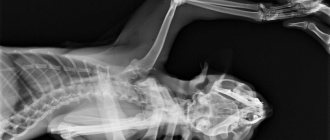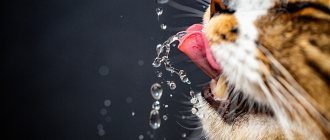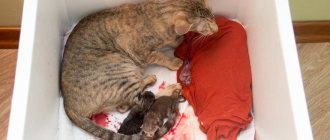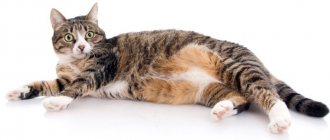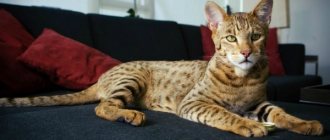People's passion for big, plump cats is inexplicable. Many people are moved by looking at photographs of giant fluffy balls, not realizing that the desire to fatten a cat to incredible sizes causes irreparable harm to his health. Some animals that received the title of “the fattest cat in the world” ended up on the pages of the Guinness Book of Records, although they later decided to remove this category due to fears that owners would deliberately overfeed their pets in order to receive this title.
Criteria for normal weight of cats and kittens
First of all, 3 factors influence a cat’s weight: its breed, age and lifestyle. For this reason, veterinarians do not recommend relying on a single standard. The norm calculated for a specific pet is much more reliable.
Breed affiliation
On average, domestic cats weigh 3.6-4.5 kg, but, depending on the breed, this figure freely “walks” up or down. For example, Maine Coons will always be larger than short-legged Munchkins, even at the kitten stage.
The constitution of the body is no less important. The norms for the “British” and “Scots” are practically the same, but the former are characterized by more developed muscles, and the latter by graceful proportions.
Differences are also observed within the breed. Most felines are characterized by pronounced sexual dimorphism. This means that a male can always be distinguished from a female thanks to the extra pounds. In most cases the difference is 1-2 kg.
Age
A cat's weight constantly changes as it grows. The minimum indicator is typical for kittens, but they gain new kilograms much faster and practically do not store fat.
By 1.5-2 years, weight stabilizes, and its deviation becomes undesirable. Older animals most often suffer from obesity and exhaustion, as metabolism slows down with age and the number of chronic diseases increases.
Nutrition and activity
Weight is affected not only by the amount of food eaten, but also by the quality of food and the frequency of meals. For this reason, homeless animals are more likely to suffer from thinness. In addition to irregular and meager nutrition, their lives are marked by excessive activity. Street cats are constantly in search of food and are forced to regularly defend their territory.
Pets live in maximum comfort. Their activity level depends on the efforts of the owners, breed and age. The main fans of games are the “Abyssinians” and “Orientals”, and the main admirers of the sofa lifestyle are the “British” and “Persians”. Because of this, the latter are more likely than others to suffer from obesity.
SpongeBob
In 2012, the Guinness Book of Records entered a new record - the fattest cat in the world was determined. It turned out to be a red-haired pet with an interesting nickname SpongeBob. Its weight is 15.5 kg, which is approximately equal to the weight of a four-year-old baby.
The cat ended up in a New York cattery, where he surprised the entire staff with his weight. The animal underwent a full examination to exclude the possibility of diseases. And it turned out that the cat was completely healthy.
True, the nursery staff are sure that excess weight is not the norm for a 9-year-old cat. And they try to help him get rid of the extra pounds through a special diet and special exercises. Veterinarians expect that losing excess weight will allow the cat to move normally.
How to visually understand that your pet has a normal weight
A cat's normal weight can be easily determined by its proportions. In the absence of deviations, the animal’s body corresponds to the following indicators:
- clearly defined waist;
- a toned stomach with a thin layer of fat;
- poorly visible ribs and pelvis that can be palpated.
A predominance of muscle mass over fat is also recommended. It is easy to identify in short-haired representatives due to its more pronounced relief.
Normal development of kittens of different breeds
At birth, most kittens weigh between 70-130 g. Maximum weight gain is observed in the first month of life. The average daily gain is 15 g, so by 4 weeks after birth many animals reach 500 g.
You can see detailed changes in body weight from 1 to 12 months in different breeds in the table below.
| Breed | Weight by month (kg) | ||||||
| 1 | 2 | 3-4 | 4-6 | 6-8 | 8-10 | 10-12 | |
| British | 0,56-0,83 | 1,15-1,6 | 1,7-4 | 2,65-5,6 | 3,6-6 | 4-7 | 4,2-8 |
| Scottish | 0,25-0,75 | 0,42-1,8 | 1-3,9 | 2,2-5,5 | 2,3-6,1 | 2,6-6,6 | 2,6-7 |
| Maine Coon | 0,55-0,75 | 1,1-1,6 | 1,6-4 | 2,9-6 | 3,2-7 | 3,8-7,3 | 4-8,7 |
| Don Sphynx | 0,2-0,4 | 0,5-0,8 | 1-3 | 1,3-3,6 | 2,2-5,1 | 2,8-5,7 | 3,2-6,4 |
| Canadian Sphynx | 0,4-0,65 | 0,9-1,3 | 1,5-2,5 | 1,9-3 | 2,6-4,4 | 3,1-4,8 | 3,4-6,8 |
| Persian | 0,37-0,5 | 0,6-1 | 0,95-2,2 | 1,4-3,6 | 2,3-4,3 | 2,8-5,6 | 3,5-6,2 |
| Siamese | 0,23-0,7 | 0,52-1,6 | 1-3,3 | 1,2-4,1 | 1,7-4,6 | 2-5,1 | 2,3-5,6 |
| Siberian | 0,35-0,74 | 0,59-1,45 | 1-4 | 1,6-5,1 | 2,7-5,8 | 3-6,2 | 3,5-7 |
| Russian blue | 0,25-0,74 | 0,45-1,7 | 1-3,9 | 1,7-4,9 | 2,3-5,3 | 2,5-5,5 | 2,5-5,8 |
| Abyssinian | 0,3-0,8 | 0,55-1,5 | 1-3,7 | 1,5-4,5 | 2-5 | 2,3-6 | 2,5-7,5 |
| Ragdoll | 0,28-0,71 | 0,49-1,47 | 1,2-3,67 | 1,7-5,69 | 2,5-6,3 | 3-7,2 | 3,3-7,7 |
| Exotic | 0,25-0,77 | 0,47-1,55 | 1,2-3,5 | 1,7-4,7 | 2,1-5,2 | 2,4-5,7 | 2,8-6,2 |
| Bengal | 0,35-0,56 | 0,64-1,3 | 1,2-3 | 1,7-4,3 | 2,8-5,1 | 3,2-5,6 | 3,3-6,3 |
The table shows that after reaching six months, the rate of weight gain slows down. At this stage, puberty occurs. After this, the weight gain is less significant.
The difference between males and females is also clearly visible, but at first there may be slight deviations within the litter. That is, some girls may be ahead of boys due to a more balanced diet. It may be related to the total number of newborns (lack of nipples) and the degree of milk production of the recently given birth pet.
Separately, we should consider the developmental features of outbred kittens and mixed-breed kittens. First, let's outline their differences:
- Mongrels (outbred). Obtained through uncontrolled and most often natural mating. They do not have documents due to the unknown breed of their parents. They can be born as a result of mating of mixed breeds or other mongrels. In this case, the maximum mixture of a wide variety of breeds can be seen.
- Metis. Obtained by mating animals belonging to different breeds. They do not have documents due to the unofficial nature of such matings. They have more predictable behavior and appearance.
Due to the peculiarities of birth, the norm for mongrels and mixed breeds is very different from general standards. A pet born not according to the rules of selection can take traits from both parents at once. As a result, even here the most reliable method remains visual inspection.
How much should an adult cat weigh: table by age and breed
As noted above, weight gain continues until approximately 1.5-2 years. From this moment on, it stabilizes, so the owner can simply hold it.
The table below shows the weight norms for male cats by age and breed.
| Breed | Weight, kg) | |
| Males from 1.5 to 8 years | Females from 1.5 to 8 years | |
| British | 5-8 | 3-6 |
| Scottish | 4-7 | 3-5 |
| Maine Coon | 8-12 | 4,6-7,5 |
| Don Sphynx | 5-7 | 3,5-4 |
| Canadian Sphynx | 5-7 | 3,5-4 |
| Persian | 4-6,2 | 3-5 |
| Siamese | 4-5,6 | 3-4 |
| Siberian | 6-9 | 3,5-7 |
| Russian blue | 3,5-5,8 | 3-4 |
| Abyssinian | 4-7,5 | 3-4,5 |
| Ragdoll | 7-10 | 4-6 |
| Exotic | 4-6,2 | 3-5 |
| Bengal | 5-7 | 3,5-4,5 |
When the animal reaches 8 years of age, it is classified as elderly. The processes in his body slow down. Most of what you eat is stored as fat, and due to reduced activity, muscle mass noticeably decreases. As a result, a pet that meets the above standards may look much more well-fed. This is due to the fact that fat is always lighter than muscle. This feature of the body once again confirms the advisability of a visual inspection.
It is also worth mentioning the relationship with castration and sterilization. After surgery, animals often weigh more than normal. The reasons here are the same as with aging: a slowdown in metabolism and a decrease in usual activity.
Meow
The world said goodbye to the most obese cat in the United States quite recently - on May 18, 2018. He lived in Santa Fe, New Mexico, and in just two years of his life, Meow gained 18 kg. The glutton's story began in April 2012 with the fact that an 87-year-old old woman brought Meow to an animal shelter. The pensioner made this decision because she was no longer able to guarantee her beloved cat the necessary care. Specialists prescribed a rehabilitation course for the cat, and at the same time, photographs of the fat white-and-red cat were distributed everywhere.
After publicity, Meow's story hit the press and he was bombarded with invitations to various kinds of TV shows. The shelter workers decided in this way for TV viewers to learn more about the history of the cat, and also focused the attention of the breeders on the problem of excess weight in pets. Meow was immediately put on a strict diet, and he even managed to lose a few kilograms, but due to serious obesity, the cat’s lungs failed.
Deviations from normal weight in cats and kittens - and what the owner should do
The average weight of an adult cat should not deviate significantly up or down. In the first case, there is a risk of obesity, and in the second - exhaustion. In addition to the number on the scale, the appearance and behavior of the animal can tell about these problems.
Obesity
With excess body weight, the cat becomes as passive and lazy as possible. She is reluctant to play with toys and lies on the sofa almost all the time, as it becomes difficult for her to move. She can no longer jump high. When examining the body, you may notice the following changes:
- the appearance of clearly visible fat deposits on the stomach, back and face;
- loss of a pronounced waist and bone line;
- difficulty or impossibility of palpating the ribs and pelvis due to fat.
To get rid of extra pounds, it is recommended to reduce the volume of the daily portion and increase the activity time with the help of various teasers, game complexes and interactive toys.
If the animal does not eat enough and constantly begs, increase the number of feedings without increasing the total calorie content. Many pets simply do not feel full, so you should not rely on their hungry eyes with a waist that is far from a wasp.
Exhaustion
If your cat's weight has dropped below the recommended norm, be sure to confirm possible malnutrition with a visual inspection. The need for urgent weight gain can be determined by the following signs:
- a pronounced line of rib and pelvic bones, appearing directly through the skin;
- a small number of muscles and a protruding spine;
- lack of subcutaneous fat on a strongly sunken tummy.
The most common cause of exhaustion is nutritional problems. This includes low calorie content, an unbalanced diet and a discrepancy with the animal’s taste preferences. In the first case, there is a lack of calories, in the second, a lack of proteins and fats, and in the third, a banal refusal to eat.
To eliminate body weight deficiency, you need to act based on the situation:
- Review the daily serving amount. The norms for dry food can be found on the packaging, but when feeding “natural” it is better to use a special formula.
- Namely: adjust the ratio of proteins, fats and carbohydrates. Their percentage ratio should be 52:36:12.
- Choose food that is more attractive to your pet. Don't rush to change brands. Chances are that your pet just doesn't like the taste of chicken.
If your pet eats dry kibble, then it makes sense to look for a special line of food with a high calorie content. It will make it easier to gain kilograms and eliminate the lack of substances important for the cat’s body.
When you need veterinary help
You should contact your veterinarian if you are severely obese or malnourished. Both cases are fraught with quite serious complications and are often associated with concomitant diseases (endocrine, cardiovascular). The following symptoms will help you find out about the pathology:
- lethargy and apathy;
- change in appetite (deterioration or perversion);
- frequent vomiting;
- bowel dysfunction, including changes in the color, shape and consistency of stool;
- unpleasant odor from the mouth;
- increase or decrease in temperature;
- increased salivation;
- excessive tearing or suppuration of the eyes;
- yellowing or blue discoloration of mucous membranes.
If the disease is confirmed, the animal will require specific treatment. In addition, the doctor will help you choose a special diet with low or high calorie content.
How to weigh your pet correctly
You can find out how much a cat weighs at a veterinarian's appointment or right at home. In the second case, you will need electronic scales. Mechanical ones are suitable only for the calmest pets. In other cases, the arrow will constantly jump, not having time to lock on.
The most reliable option is to weigh it in your hands, but you can also put the animal in some kind of container or secure it in a bag. In the first case, it will be necessary to subtract your own weight from the resulting figure, and in all others, a lot of additional devices.
Tulle
Nine-year-old Tulle has surpassed previous participants in the ranking of fat cats. The red-haired pet, which has gained 20 kg, lives in Denmark.
A cat, when it lies motionless, can be confused with a small fluffy pillow or ottoman. The owners cannot refuse the cute little cat his constant desire to eat something tasty. Over time, Tulle lost interest in outdoor games and indulged in laziness. It is difficult for the cat to walk, and in order not to get up, he has learned to roll like a ball, and in this way he gets to the bowl of food. Of all the activities, Tulle chooses sleep.
Currently, the hero is following a diet, because his weight is approaching a critical point.
